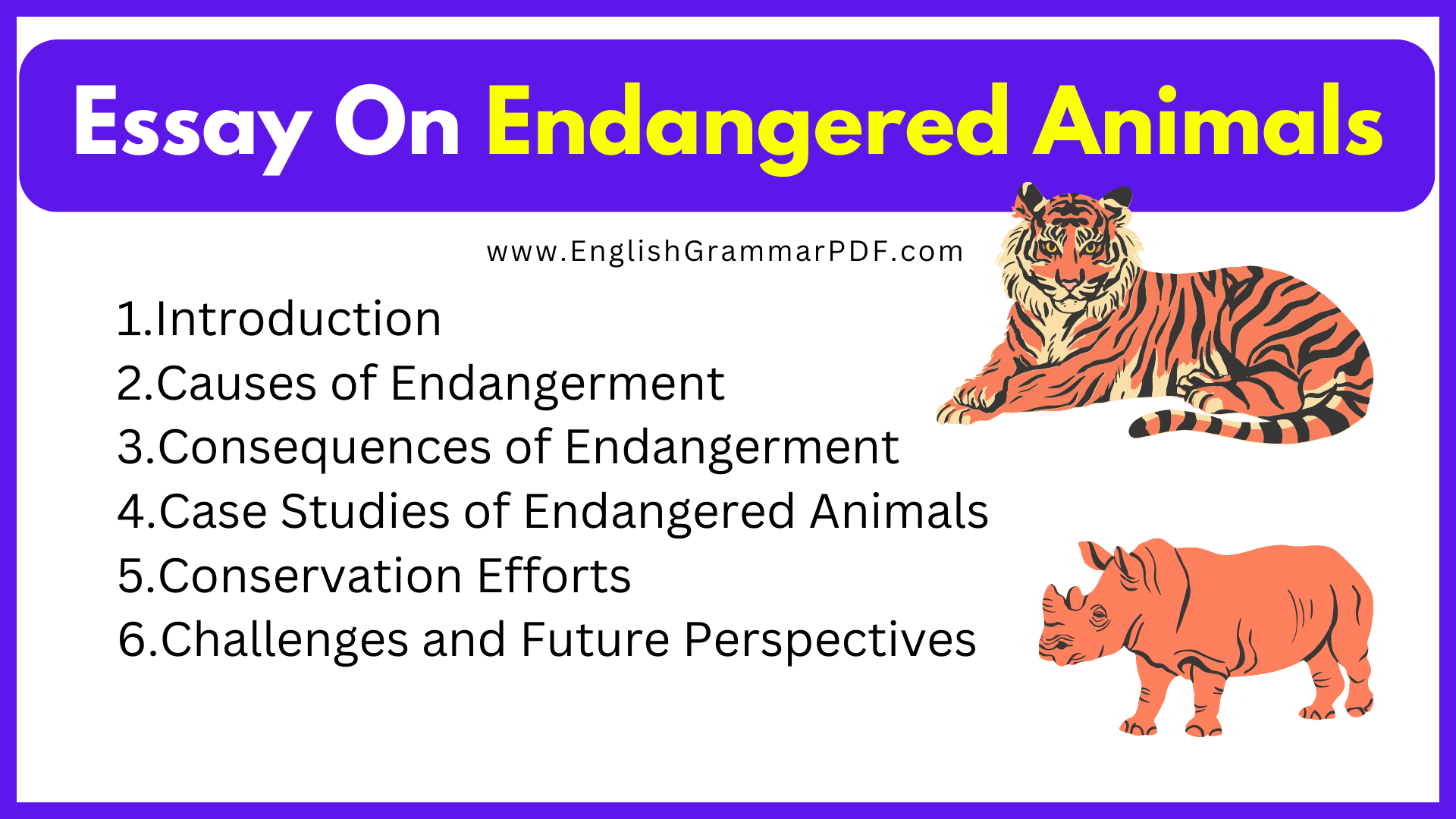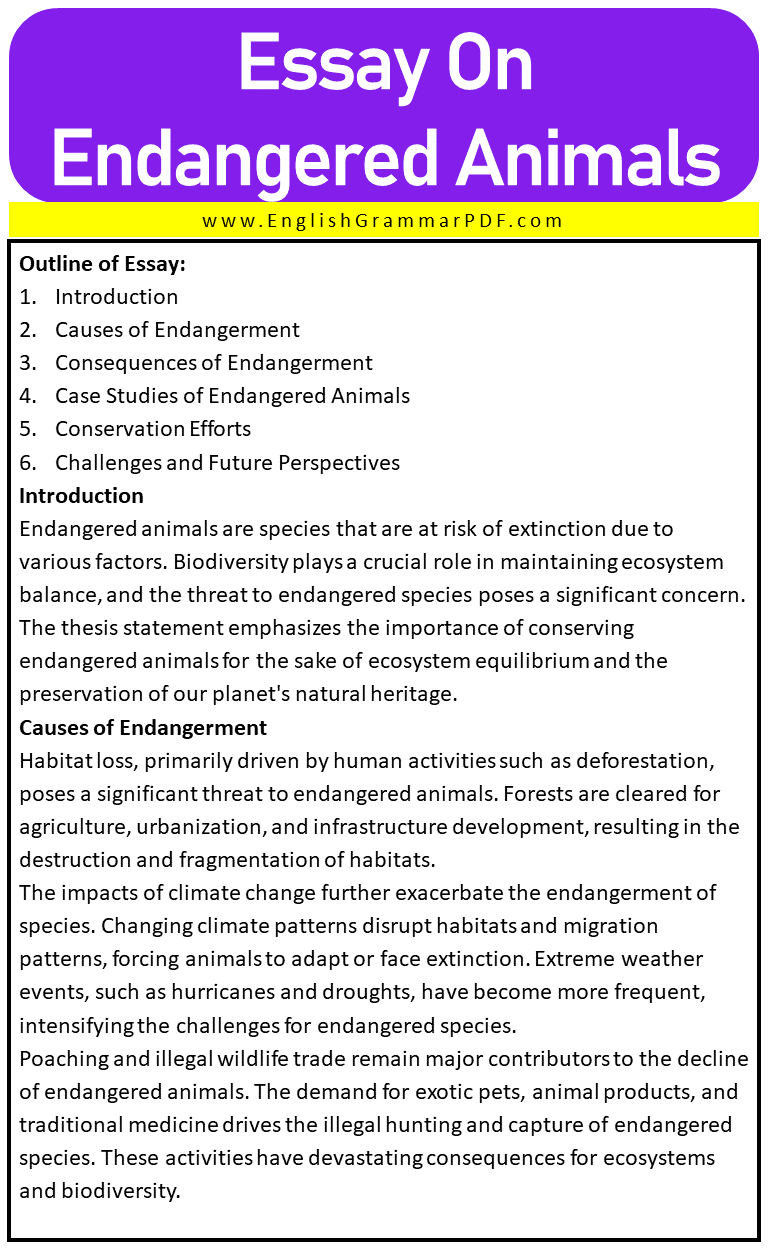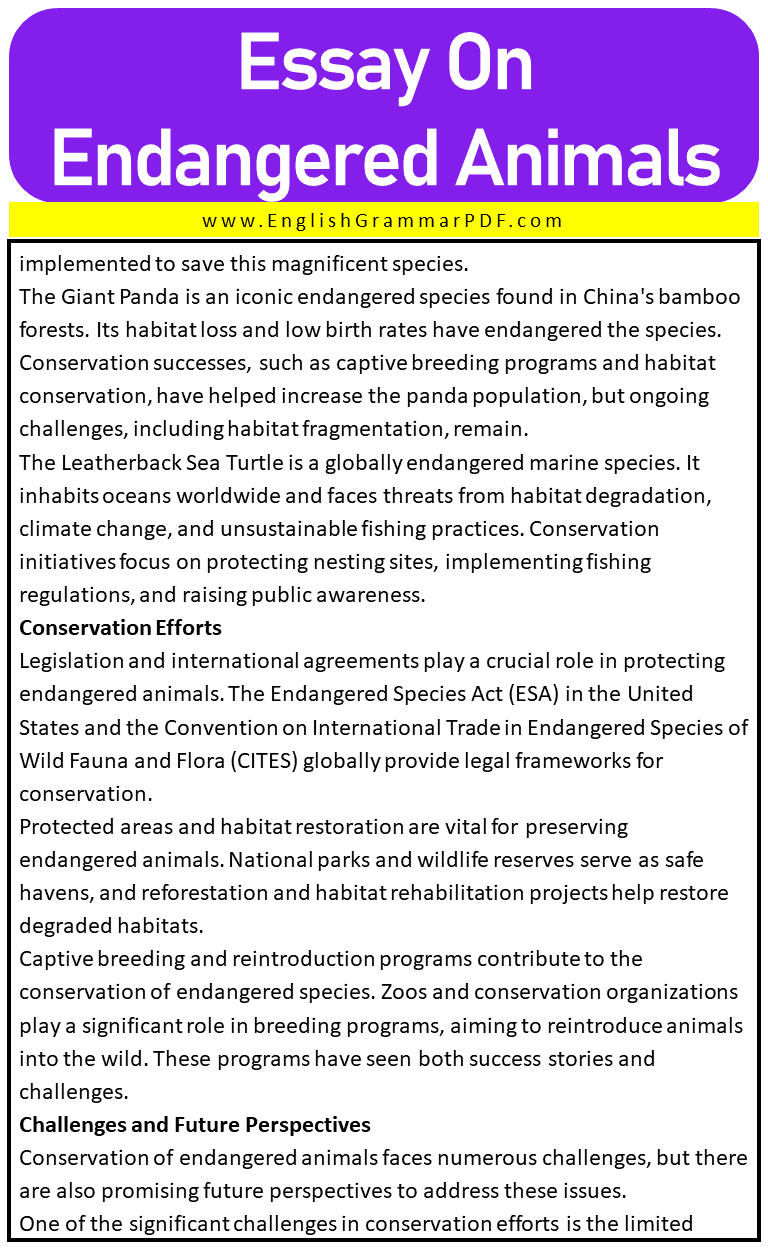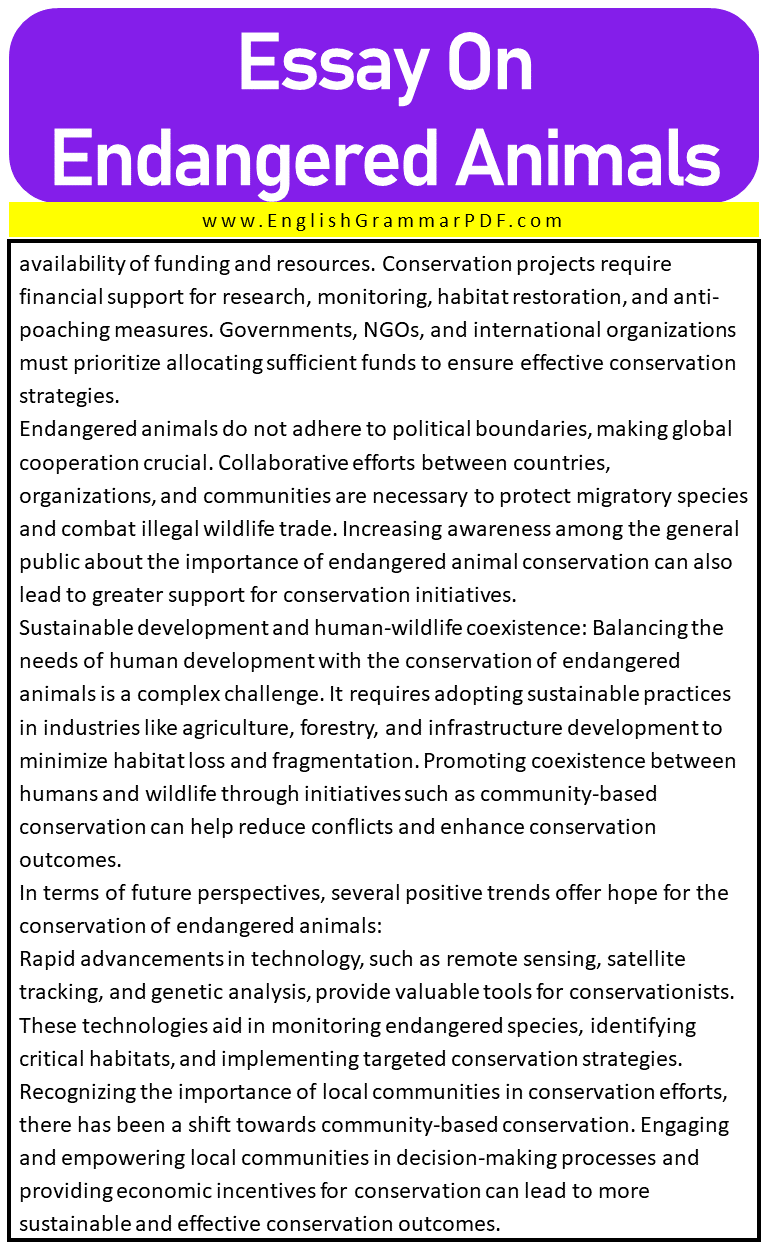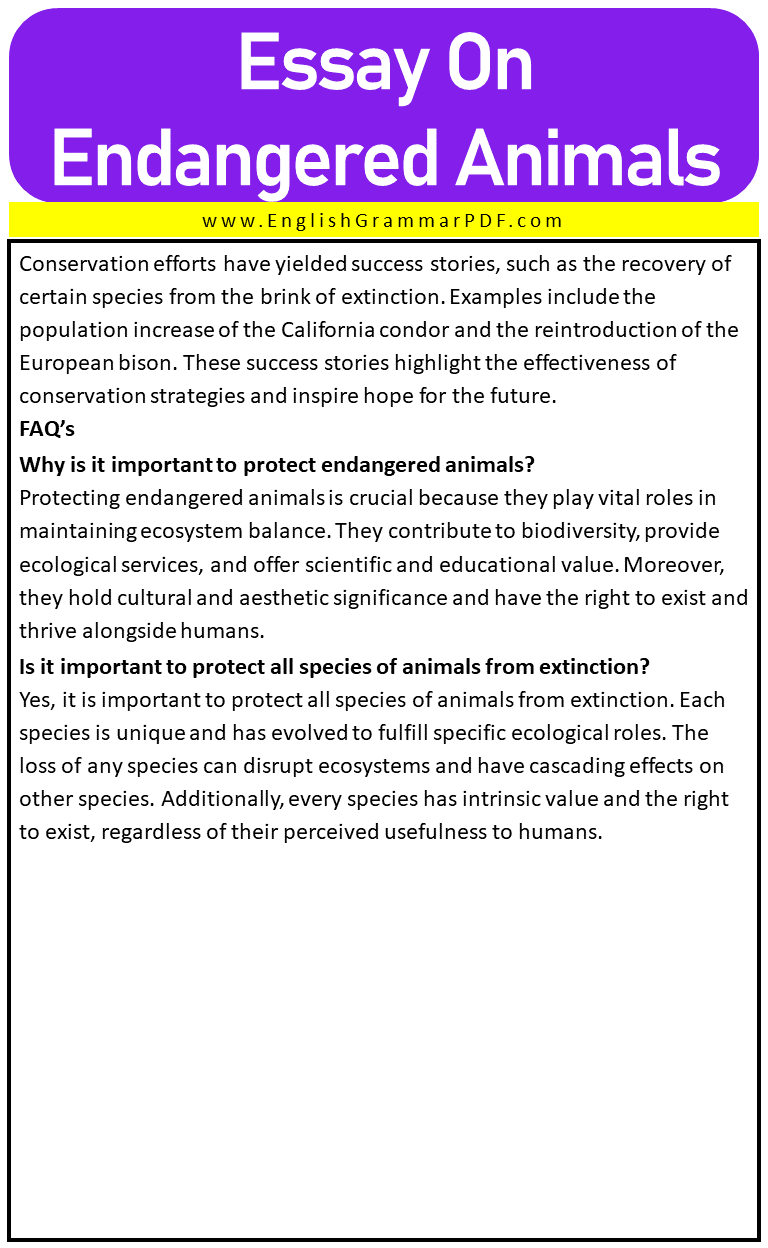Essay on Endangered Animals
Outline of Essay:
- Introduction
- Causes of Endangerment
- Consequences of Endangerment
- Case Studies of Endangered Animals
- Conservation Efforts
- Challenges and Future Perspectives
Introduction
Endangered animals are species that are at risk of extinction due to various factors. Biodiversity plays a crucial role in maintaining ecosystem balance, and the threat to endangered species poses a significant concern. The thesis statement emphasizes the importance of conserving endangered animals for the sake of ecosystem equilibrium and the preservation of our planet’s natural heritage.
Causes of Endangerment
Habitat loss, primarily driven by human activities such as deforestation, poses a significant threat to endangered animals. Forests are cleared for agriculture, urbanization, and infrastructure development, resulting in the destruction and fragmentation of habitats.
The impacts of climate change further exacerbate the endangerment of species. Changing climate patterns disrupt habitats and migration patterns, forcing animals to adapt or face extinction. Extreme weather events, such as hurricanes and droughts, have become more frequent, intensifying the challenges for endangered species.
Poaching and illegal wildlife trade remain major contributors to the decline of endangered animals. The demand for exotic pets, animal products, and traditional medicine drives the illegal hunting and capture of endangered species. These activities have devastating consequences for ecosystems and biodiversity.
Consequences of Endangerment
The consequences of endangerment are far-reaching and have significant impacts on ecosystems, economies, and our ethical and cultural values. Firstly, there are ecological consequences to consider. When a species becomes endangered and eventually extinct, it disrupts the delicate balance of ecosystems. Each species plays a vital role in maintaining ecological processes such as pollination, seed dispersal, and nutrient cycling. The loss of a single species can have a ripple effect throughout the entire ecosystem, leading to imbalances, reduced biodiversity, and a decline in ecosystem services.
Moreover, the economic impacts of endangerment cannot be overlooked. Many endangered animals are charismatic and attract tourists, contributing to local economies through wildlife tourism. For example, tourists flock to countries like Kenya and South Africa for wildlife safaris, generating substantial revenue. The loss of these animals could result in a decline in tourism and have detrimental effects on local communities that rely on this income.
There are also ethical and cultural implications of endangerment. Many species hold cultural significance, representing a community’s identity, folklore, and spiritual beliefs. The loss of these species not only erodes cultural heritage but also affects the moral responsibility humans have towards other species. Preserving endangered animals is not only a matter of ecological and economic value but also a recognition of the intrinsic worth of all living beings and the need to protect them for future generations.
Case Studies of Endangered Animals
The Sumatran Tiger is a critically endangered species. It resides in the forests of Sumatra, Indonesia. The major threats to its survival include habitat loss, poaching, and conflicts with humans. Various conservation efforts, such as habitat protection and community engagement, are being implemented to save this magnificent species.
The Giant Panda is an iconic endangered species found in China’s bamboo forests. Its habitat loss and low birth rates have endangered the species. Conservation successes, such as captive breeding programs and habitat conservation, have helped increase the panda population, but ongoing challenges, including habitat fragmentation, remain.
The Leatherback Sea Turtle is a globally endangered marine species. It inhabits oceans worldwide and faces threats from habitat degradation, climate change, and unsustainable fishing practices. Conservation initiatives focus on protecting nesting sites, implementing fishing regulations, and raising public awareness.
Conservation Efforts
Legislation and international agreements play a crucial role in protecting endangered animals. The Endangered Species Act (ESA) in the United States and the Convention on International Trade in Endangered Species of Wild Fauna and Flora (CITES) globally provide legal frameworks for conservation.
Protected areas and habitat restoration are vital for preserving endangered animals. National parks and wildlife reserves serve as safe havens, and reforestation and habitat rehabilitation projects help restore degraded habitats.
Captive breeding and reintroduction programs contribute to the conservation of endangered species. Zoos and conservation organizations play a significant role in breeding programs, aiming to reintroduce animals into the wild. These programs have seen both success stories and challenges.
Challenges and Future Perspectives
Conservation of endangered animals faces numerous challenges, but there are also promising future perspectives to address these issues.
One of the significant challenges in conservation efforts is the limited availability of funding and resources. Conservation projects require financial support for research, monitoring, habitat restoration, and anti-poaching measures. Governments, NGOs, and international organizations must prioritize allocating sufficient funds to ensure effective conservation strategies.
Endangered animals do not adhere to political boundaries, making global cooperation crucial. Collaborative efforts between countries, organizations, and communities are necessary to protect migratory species and combat illegal wildlife trade. Increasing awareness among the general public about the importance of endangered animal conservation can also lead to greater support for conservation initiatives.
Sustainable development and human-wildlife coexistence: Balancing the needs of human development with the conservation of endangered animals is a complex challenge. It requires adopting sustainable practices in industries like agriculture, forestry, and infrastructure development to minimize habitat loss and fragmentation. Promoting coexistence between humans and wildlife through initiatives such as community-based conservation can help reduce conflicts and enhance conservation outcomes.
In terms of future perspectives, several positive trends offer hope for the conservation of endangered animals:
Rapid advancements in technology, such as remote sensing, satellite tracking, and genetic analysis, provide valuable tools for conservationists. These technologies aid in monitoring endangered species, identifying critical habitats, and implementing targeted conservation strategies.
Recognizing the importance of local communities in conservation efforts, there has been a shift towards community-based conservation. Engaging and empowering local communities in decision-making processes and providing economic incentives for conservation can lead to more sustainable and effective conservation outcomes.
Conservation efforts have yielded success stories, such as the recovery of certain species from the brink of extinction. Examples include the population increase of the California condor and the reintroduction of the European bison. These success stories highlight the effectiveness of conservation strategies and inspire hope for the future.
FAQ’s
Why is it important to protect endangered animals?
Protecting endangered animals is crucial because they play vital roles in maintaining ecosystem balance. They contribute to biodiversity, provide ecological services, and offer scientific and educational value. Moreover, they hold cultural and aesthetic significance and have the right to exist and thrive alongside humans.
Is it important to protect all species of animals from extinction?
Yes, it is important to protect all species of animals from extinction. Each species is unique and has evolved to fulfill specific ecological roles. The loss of any species can disrupt ecosystems and have cascading effects on other species. Additionally, every species has intrinsic value and the right to exist, regardless of their perceived usefulness to humans.
Explore More Essays:
Download the PDF of the Essay:
